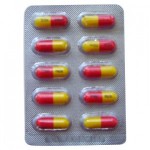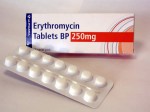 Antibiotics have assumed major role in the treatment of acne, and many of the questions involve the use of antibiotics. One of the most frequent questions concerns the difficulty in remembering to take antibiotics and perform the other elements of a good acne regimen.
Antibiotics have assumed major role in the treatment of acne, and many of the questions involve the use of antibiotics. One of the most frequent questions concerns the difficulty in remembering to take antibiotics and perform the other elements of a good acne regimen.
Remembering to take pills is difficult, for sure. Try to tie the taking of your medicine with some other action repeated in your daily routine. For instance, try storing the tablet bottle beside your slippers near your bed at night and keep a glass of water nearby. And when you wake up the next morning, chances are very high that you will notice the bottle while wearing your slippers.
Of course this trick would not work, if you have small children at home or pets who could reach your medicines. Naturally all medicines must be kept out of their reach.
If you’re on a medicine that may be taken close to meals, I would advise attaching one’s toothbrush to the medicine bottle with a rubber band. Then, each time you brush, you’ll be reminded about your medicine. This is of course, contingent upon brushing your teeth after eating.
 Tetracycline should be taken on an empty stomach as much as possible. Most forms of tetracycline are greatly affected by meals, especially by the calcium in food. That’s generally why milk is to be avoided during acne therapy.
Tetracycline should be taken on an empty stomach as much as possible. Most forms of tetracycline are greatly affected by meals, especially by the calcium in food. That’s generally why milk is to be avoided during acne therapy.
But it’s even more important that the directions for taking one’s medicine be clearly written and clearly understood. A patient by the name Teresa illustrates this point. Teresa came in with small popular acne, that is, mostly small red bumps. This is usually the easiest type of acne to clear, and it usually clears beautifully on tetracycline capsules.
Teresa was instructed to take one capsule three times a day, and on her prescription it was written “one hour a.c. or two hours p.c.”. This means “one hour before meals or two hours after meals.” Teresa was using her topical medicines faithfully and was taking her capsules, three a day, but was not clearing.
Her bumps kept getting worse instead of better even when the dose of tetracycline was increased to four a day. On her third visit, the dermatologist was fairly disturbed with the continual outbreak of new spots, and Teresa asked the doctor if there were any special way to take the medicine.
The doctor first checked with Teresa whether if she is following the instructions written on the prescription. According to the prescription, Teresa was told to take the medications one hour before meals or two hours after. Only for the doctor to find out that she has been taking the medications with her meals!
Now the doctor had the answer to Teresa’s dilemma. She is supposed to take the capsules on an empty stomach. After Teresa was notified about her mistake, she followed the instructions accordingly and her acne started to clear rapidly.
 The exception to this empty stomach rule is a drug called minocycline, a very effective tetracycline derivative, which you need not necessarily take on an empty stomach. One problem with minocycline, however, is that it’s much more expensive than regular tetracycline.
The exception to this empty stomach rule is a drug called minocycline, a very effective tetracycline derivative, which you need not necessarily take on an empty stomach. One problem with minocycline, however, is that it’s much more expensive than regular tetracycline.
In fact, we usually reserve it for difficult cases of acne because of its cost. However, in cases where patients cannot get themselves to take tetracycline on an empty stomach, it is very easy to take minocycline because they can pop a capsule at mealtime.
The prohibition against food with regular tetracycline has caused some occasional problems. Some patients may have taken tetracycline accidentally with food. Later as they realized that the label on the bottle specifically says never to do that, they panic. What actually will happen is that it will only slow down the absorption rate and will not cause any toxic effects as feared.
If you’re on regular tetracycline, you might remember the bottle-in-the-slipper trick mentioned before (provided you don’t have any little kids or pets around the house). Also, taking it a nighttime before bed usually provides you with a fairly empty stomach (unless you’re a midnight snacker).
The question many patients have is about the duration of antibiotic therapy. They worry about taking a medicine for a long time because of other side effects. This is very important because of the scare implanted in lay persons during the early days of antibiotic therapy.
At that time, lay audiences were told that use of antibiotics for a long term would cause a “resistance” to them that would preclude their use in infections at a later date.
Actually the group of antibiotics used most often in acne, that is, the tetracyclines, is found to be some of the safest drugs ever invented. While there are side effects, these are uncommon in actual practice.
Side effects of Tetracycline
 The chief side effect, usually occurring in women on doses of 500 to 1,000 milligrams and more per day, is vaginitis. Regular vaginal bacteria are knocked out by the antibiotic and yeasts overgrow.
The chief side effect, usually occurring in women on doses of 500 to 1,000 milligrams and more per day, is vaginitis. Regular vaginal bacteria are knocked out by the antibiotic and yeasts overgrow.
Then an itchy discharge can develop that is quite annoying, but this does not always mean that the patient has to stop the medication.
In many cases, since the face is the “window with which one greets the world,” it is absolutely necessary to keep up the antibiotic, and in these cases, we usually prescribe vaginal anti-yeast tablets (such as Gyne Lotrimin Tablets, now available over the counter) once or twice a week to prevent yeast infection.
There are many other drugs that can perform this function, and your doctor may have another preference. But don’t give up hope just because you get an episode of vaginitis. It’s a problem that can be very adequately controlled.
Various other side effects of taking tetracycline include nausea and, with minocycline, occasional dizzy spells. Your own dermatologist can brief you on other problems associated with tetracycline in the treatment of acne.
Antibiotics and “The Pill”
Recent reports indicate that tetracycline occasionally diminishes the contraceptive effect of the low-dose birth control pill. Therefore, if you are on the pill, ask your physician whether you should be on tetracycline simultaneously.
 If your physician doesn’t want you on the two together, he or she may want to ask your dermatologist to switch you to erythromycin, which has much the same type of activity that tetracycline has in acne, but which is only about one half to two thirds as effective when given internally.
If your physician doesn’t want you on the two together, he or she may want to ask your dermatologist to switch you to erythromycin, which has much the same type of activity that tetracycline has in acne, but which is only about one half to two thirds as effective when given internally.
One advantage is that erythromycin usually does not cause vaginitis. If you choose to stay on tetracycline during your acne therapy, you should consider using a second form of contraception. Oral contraceptives are combinations of estrogens and progestins.
While the estrogen component is not acne-causing, the progestin in most pills is broken down by the body into a substance that has androgenic (male hormone) effects. This makes acne worse. There are, however, several types of birth control pills (BCPs) that are not usually thought to make acne worse.
In these BCPs, the progestin is metabolized to an estrogenic substance which may actually help clear acne. Ask your physician which of these so-called estrogen-dominant types is preferred for you. Your doctor will usually be glad to change types if you haven’t had any pill-related problems.
For most BCPs, the pill + skin = acne. Ask your doctor for one that will not satisfy this equation.
Antibiotics and Teeth
There has been widespread concern over the possibility of tooth staining while a person in taking tetracycline for acne. This is another one of the really misplaced bits of information that gets planted in the lay literature without adequate explanation.
Mothers, fathers, and adolescent patients ask this question repeatedly. Tetracycline can cause tooth staining, and even malformation of the teeth, if it’s taken before the age of eight. This can also happen to the fetus of a woman who is pregnant, if she takes tetracycline.
Therefore, physicians who prescribe tetracycline are very cautious not to give it to young children or pregnant mothers. If neither of these conditions applies, that is, if you’re not under the age of eight, and if you’re not pregnant, there can be no dental problems with regular tetracycline.
With the more potent minocycline, there have been very rare reports of adult tooth staining that appears irreversible, so if you are on minocycline for a prolonged time, you should ask your dentist to color-match your teeth so that any color changes may be noticed early and the medicine stopped.
The general recommendation in regard to minocycline would change somewhat in light of this newest information. Minocycline can still be used to treat severe acne patients, but can be warned to them about the tooth-staining properties of the medicine, and stop it at the first sign of darkening of the enamel of the teeth.
A recent study concerning tetracycline was reviewed at the American Academy of Dermatology meeting in December 1981. A large group of patients on tetracycline for acne were followed carefully over several years, and no problems arose in the adolescents’ health, either by physical examination or by lab studies.
Of course, as with any prescription medicine, your dermatologist will want to see adolescent patients from time to time, to make sure they are on the right dose of the medication and that all their topical medications are being used correctly.



